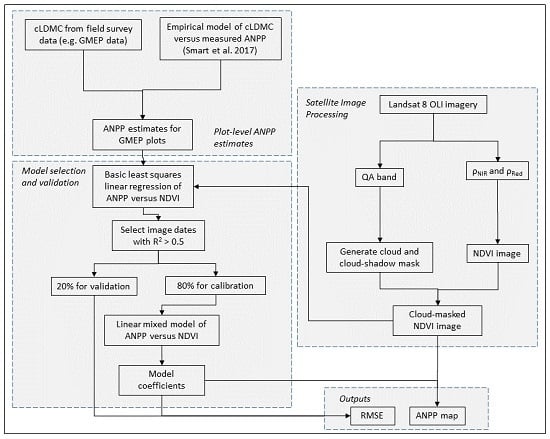Regional-Scale High Spatial Resolution Mapping of Aboveground Net Primary Productivity (ANPP) from Field Survey and Landsat Data: A Case Study for the Country of Wales
Abstract
:1. Introduction
- Develop a method for using field-based ANPP estimates, distributed across Wales, to produce regression relationships with NDVI imagery that can be used to estimate ANPP across Wales.
- Identify and assess the impact of issues, such as the timing of the images and the type of habitat, which may affect the accuracy of the estimated ANPP.
- Discuss the limitations and potential for implementing an operational system for mapping ANPP using field measurements and remote sensing data.
2. Materials and Methods
2.1. Study Area
2.2. ANPP Estimates from Field Observations
2.3. Satellite Image Processing
2.4. Methodological Framework
2.5. Model Selection
2.6. Model Validation and Uncertainty Estimation
3. Results
3.1. Mean ANPP Values across Wales
3.2. Seasonal Dependence of the Relationship between NDVI and ANPP
3.3. Temporal Matching between the In Situ Data and Satellite Imagery
3.4. Models for Predicting ANPP from NDVI Imagery
3.5. Accuracy Assessment and Validation
3.6. What Is Possible with Cloud-Free Imagery
4. Discussion
4.1. General Experimental Framework
- Collect field data for ANPP across a productivity gradient for the habitats in question (future work will explore the use of the satellite data for targeting field work).
- Acquire and pre-process satellite NDVI data.
- Search through available satellite data to identify the image which gives the best relationship with ANPP (highest R2).
- Apply the best model to NDVI imagery to map ANPP outside the field survey plots.
- Evaluate the derived model using a reserved validation dataset to calculate the image-specific uncertainty (RMSE) in ANPP estimates.
4.2. Data Requirements for This Approach
- (1)
- Widespread plot level field data that cover a range of habitats and ANPP values. Such datasets already exist in the UK, due to the Countryside Survey [30] and GMEP [31] projects, and for many countries across the world (see http://www.givd.info/). Similar datasets are likely to become increasing available as countries implement more fine-scale monitoring of their natural capital.
- (2)
- The field data need to provide sufficient plots per image to enable the production of a robust relationship. It is important to note that cloud-cover will tend to decrease the number of available plots within the image. The relationships presented here were based on between 42 and 128 plots (Table 5), with the best relationships using 109 plots; however, in this work, we have not attempted to determine the optimum number of plots.
- (3)
- Cloud-free data within a relatively narrow time window (March–May). Currently, the availability of suitable cloud free imagery for some regions, such as the UK, is limited; however, since the launch of the Sentinel-2 satellites, suitable optical imagery is being more frequently collected, thereby increasing the likelihood that cloud free imagery will be acquired. Hence, it is conceivable that regional scale vegetation productivity maps could be produced and updated every few years.
4.3. Potential Applications
4.4. Limitations and Future Work
5. Conclusions
Supplementary Materials
Supplementary File 1Acknowledgments
Author Contributions
Conflicts of Interest
References
- Cardinale, B.J.; Matulich, K.L.; Hooper, D.U.; Byrnes, J.E.; Duffy, E.; Gamfeldt, L.; Balvanera, P.; O’Connor, M.I. The functional role of producer diversity in ecosystems. Am. J. Bot. 2011, 98, 572–592. [Google Scholar] [CrossRef] [PubMed]
- Fraser, L.H.; Pither, J.; Jentsch, A.; Sternberg, M.; Zobel, M.; Askarizadeh, D.; Bartha, S.; Beierkuhnlein, C.; Bennett, J.A.; Bittel, A.; et al. Worldwide evidence of a unimodal relationship between productivity and plant species richness. Science 2015, 349, 302–306. [Google Scholar] [CrossRef] [PubMed] [Green Version]
- Haberl, H.; Erb, K.-H.; Krausmann, F.; Gaube, V.; Bondeau, A.; Plutzar, C.; Gingrich, S.; Lucht, W.; Fischer-Kowalski, M. Quantifying and mapping the human appropriation of net primary production in earth’s terrestrial ecosystems. Proc. Natl. Acad. Sci. USA 2007, 104, 12942–12947. [Google Scholar] [CrossRef] [PubMed]
- Scurlock, J.M.O.; Johnson, K.; Olson, R.J. Estimating net primary productivity from grassland biomass dynamics measurements. Glob. Chang. Biol. 2002, 8, 736–753. [Google Scholar] [CrossRef]
- Jung, M.; Vetter, M.; Herold, M.; Churkina, G.; Reichstein, M.; Zaehle, S.; Ciais, P.; Viovy, N.; Bondeau, A.; Chen, Y.; et al. Uncertainties of modeling gross primary productivity over Europe: A systematic study on the effects of using different drivers and terrestrial biosphere models. Glob. Biogeochem. Cycles 2007, 21, GB4021. [Google Scholar] [CrossRef]
- Morton, D.; Rowland, C.; Wood, C.; Meek, L.; Marston, C.; Smith, G.; Wadsworth, R.; Simpson, I. Countryside Survey: Final Report for LCM2007—The New UK Land Cover Map; CS Technical Report No 11/07; Centre for Ecology & Hydrology: Bailrigg, UK, 2011. [Google Scholar]
- Hansen, M.; Egorov, A.; Roy, D.P.; Potapov, P.; Ju, J.; Turubanova, S.; Kommareddy, I.; Loveland, T.R. Continuous fields of land cover for the conterminous United States using Landsat data: First results from the Web-Enabled Landsat Data (WELD) project. Remote Sens. Lett. 2011, 2, 279–288. [Google Scholar] [CrossRef]
- Benz, U.C.; Hofmann, P.; Willhauck, G.; Lingenfelder, I.; Heynen, M. Multi-resolution, object-oriented fuzzy analysis of remote sensing data for GIS-ready information. ISPRS J. Photogram. Remote Sens. 2004, 58, 239–258. [Google Scholar] [CrossRef]
- Morton, R.D.; Rowland, C.S. Developing and Evaluating an Earth Observation-Enabled Ecological Land Cover Time Series System; JNCC Report No. 563; JNCC: Peterborough, ON, Canada, 2015; 69p.
- Running, S.W.; Nemani, R.R.; Heinsch, F.A.; Zhao, M.; Reeves, M.; Hashimoto, H. A continuous satellite-derived measure of global terrestrial primary production. BioScience 2004, 54, 547–560. [Google Scholar] [CrossRef]
- Hansen, M.C.; DeFries, R.S.; Townshend, J.R.G.; Sohlberg, R.; Dimiceli, C.; Carroll, M. Towards an operational MODIS continuous field of percent tree cover algorithm: Examples using AVHRR and MODIS data. Remote Sens. Environ. 2002, 83, 303–319. [Google Scholar] [CrossRef]
- Lambin, E. Monitoring forest degradation in tropical regions by remote sensing: Some methodological issues. Glob. Ecol. Biogeogr. 2013, 8, 191–198. [Google Scholar] [CrossRef]
- Zhao, M.; Heinsch, F.A.; Nemani, R.R.; Running, S.W. Improvements of the MODIS terrestrial gross and net primary production global data set. Remote Sens. Environ. 2005, 95, 164–176. [Google Scholar] [CrossRef]
- Tucker, C.J.; Vanpraet, C.L.; Sharman, M.J.; van Ittersum, G. Satellite remote sensing of total herbaceous biomass production in the Senegalese Sahel: 1980–1984. Remote Sens. Environ. 1985, 17, 233–250. [Google Scholar] [CrossRef]
- Gitelson, A.A.; Viña, A.; Masek, J.G.; Verma, S.B.; Suyker, A.E. Synoptic monitoring of gross primary productivity of maize using Landsat data. IEEE Geosci. Remote Sens. Lett. 2008, 5, 133–137. [Google Scholar] [CrossRef]
- Liu, Y.; Ju, W.; He, H.; Wang, S.; Sun, R.; Zhang, Y. Changes of net primary productivity in China during recent 11 years detected using an ecological model driven by MODIS. Front. Earth Sci. 2013, 7, 112–127. [Google Scholar] [CrossRef]
- Fu, D.; Chen, B.; Zhang, H.; Wang, J.; Black, T.A.; Amiro, B.D.; Bohrer, G.; Bolstad, P.; Coulter, R.; Rahman, A.F.; et al. Estimating landscape net ecosystem exchange at high spatial-temporal resolution based on Landsat data, an improved upscaling model framework, and eddy covariance flux measurements. Remote Sens. Environ. 2014, 141, 90–104. [Google Scholar] [CrossRef]
- Paruelo, J.M.; Epstein, H.E.; Lauenroth, W.K.; Burke, I.C. ANPP Estimates from NDVI for the Central Grassland Region of the United States. Ecology 1997, 78, 953–958. [Google Scholar] [CrossRef]
- Hill, R.A.; Smith, G.M. Land cover heterogeneity in Great Britain as identified in Land Cover Map 2000. Int. J. Remote Sens. 2005, 26, 5467–5473. [Google Scholar] [CrossRef]
- Box, E.O.; Holben, B.N.; Kalb, V. Accuracy of the AVHRR vegetation index as a predictor of biomass, primary productivity and net CO2 flux. Vegetatio 1989, 80, 71–89. [Google Scholar] [CrossRef]
- Seaquist, J.W.; Olsson, L.; Ardö, J. A remote sensing-based primary production model for grassland biomes. Ecol. Model. 2003, 169, 131–155. [Google Scholar] [CrossRef]
- Monteith, J.L. Solar radiation and productivity in tropical ecosystems. J. Appl. Ecol. 1972, 9, 747–766. [Google Scholar] [CrossRef]
- Turner, D.P.; Ritts, W.D.; Cohen, W.B.; Maeirsperger, T.K.; Gower, S.T.; Kirschbaum, A.A.; Running, S.W.; Zhao, M.; Wofsy, S.C.; Dunn, A.L.; et al. Site-level evaluation of satellite-based global terrestrial gross primary production and net primary production monitoring. Glob. Chang. Biol. 2005, 11, 666–684. [Google Scholar] [CrossRef]
- Russell, S.; Jones, L.; Reynolds, B.; Robinson, D.; Blackstock, T. Status and changes in the UK ecosystems and their services to society: Wales. In The UK National Ecosystem Assessment: Synthesis of the Key Findings; Watson, B., Albon, S., Eds.; UNEP-WCMC: Cambridge, UK, 2011. [Google Scholar]
- Kleyer, M.; Bekker, R.M.; Knevel, I.C.; Bakker, J.P.; Thompson, K.; Sonnenschein, M.; Poschlod, P.; van Groenandael, J.M.; Klimes, L.; Klimesova, J.; et al. The LEDA traitbase: A database of life-history traits of the NW European flora. J. Ecol. 2008, 96, 1266–1274. [Google Scholar] [CrossRef]
- Smart, S.M.; Glanville, H.C.; del Carmen Blanes, M.; Mercado, L.M.; Emmett, B.A.; Jones, D.L.; Jackson, C.B.; Marrs, R.H.; Butler, A.; Marshall, M.R.; et al. Leaf Dry Matter Content is better at predicting above-ground Net Primary Production than Specific Leaf Area. Funct. Ecol. 2017, 38, 42–49. [Google Scholar] [CrossRef]
- Zanter, K. Landsat 8 (L8) Data Users Handbook; Version 2; 2016; LSDS-1574; Department of the Interior U.S. Geological Survey. Available online: https://landsat.usgs.gov/landsat-8-l8-data-users-handbook (accessed on 2 August 2017).
- USGS. Product Guide Landsat 4–7 Climate Data Record (CDR) Surface Reflectance; Version 7.2; Department of the Interior U.S. Geological Survey: Reston, VA, USA, 2017.
- Martin, A.R.; Rapidel, B.; Roupsard, O.; Van den Meersche, K.; Virginio Filho, M.; Barrios, M.; Isaac, M.E. Intraspecific trait variation across multiple scales: The leaf economics spectrum in coffee. Funct. Ecol. 2016, 31, 604–612. [Google Scholar] [CrossRef]
- Smart, S.; Maskell, L.C.; Dunbar, M.J.; Emmett, B.A.; Marks, S.; Norton, L.R.; Rose, P.; Simpson, I.C. An Integrated Assessment of Countryside Survey Data to Investigate Ecosystem Services in Great Britain; Countryside Survey Technical Report No. 10/07; Centre for Ecology & Hydrology: Bailrigg, UK, 2010. [Google Scholar]
- Emmett, B.E.; the GMEP Team. Glastir Monitoring & Evaluation Programme. Second Year Annual Report to Welsh Government (Contract Reference: C147/2010/11). NERC/Centre for Ecology & Hydrology (CEH Project: NEC04780). 2015. Available online: https://core.ac.uk/download/pdf/33453746.pdf (accessed on 2 August 2017).
- Maskell, L.C.; Crowe, A.; Dunbar, M.J.; Emmett, B.; Henrys, P.; Keith, A.M.; Norton, L.R.; Scholefield, P.; Clark, D.B.; Simpson, I.C.; et al. Exploring the ecological constraints to multiple ecosystem service delivery and biodiversity. J. Appl. Ecol. 2013, 50, 561–571. [Google Scholar] [CrossRef]
- Bawa, K.; Rose, J.; Ganeshaiah, K.N.; Barve, N.; Kiran, M.C.; Umashaanker, R. Assessing biodiversity from space: An example from the Western Ghats, India. Conserv. Ecol. 2002, 6, 7. [Google Scholar] [CrossRef]
- Reichstein, M.; Bahn, M.; Ciais, P.; Frank, D.; Mahecha, M.D.; Seneviratne, S.I.; Zscheischler, J.; Beer, C.; Buchmann, N.; Frank, D.C.; et al. Climate extremes and the carbon cycle. Nature 2013, 500, 287–295. [Google Scholar] [CrossRef] [PubMed]
- Gao, B.C. NDWI—A normalized difference water index for remote sensing of vegetation liquid water from space. Remote Sens. Environ. 1996, 58, 257–266. [Google Scholar] [CrossRef]
- Wang, Q.; Adiku, S.; Tenhunen, J.; Granier, A. On the relationship of NDVI with leaf area index in a deciduous forest site. Remote Sens. Environ. 2005, 94, 244–255. [Google Scholar] [CrossRef]
- Goswami, S.; Gamon, J.; Vargas, S.; Tweedie, C. Relationships of NDVI, Biomass, and Leaf Area Index (LAI) for six key plant species in Barrow, Alaska. PeerJ Prepr. 2015, 3, e913v1. [Google Scholar] [CrossRef]
- Pettorelli, N. The Normalised Difference Vegetation Index; Oxford University Press: Oxford, UK, 2013. [Google Scholar]
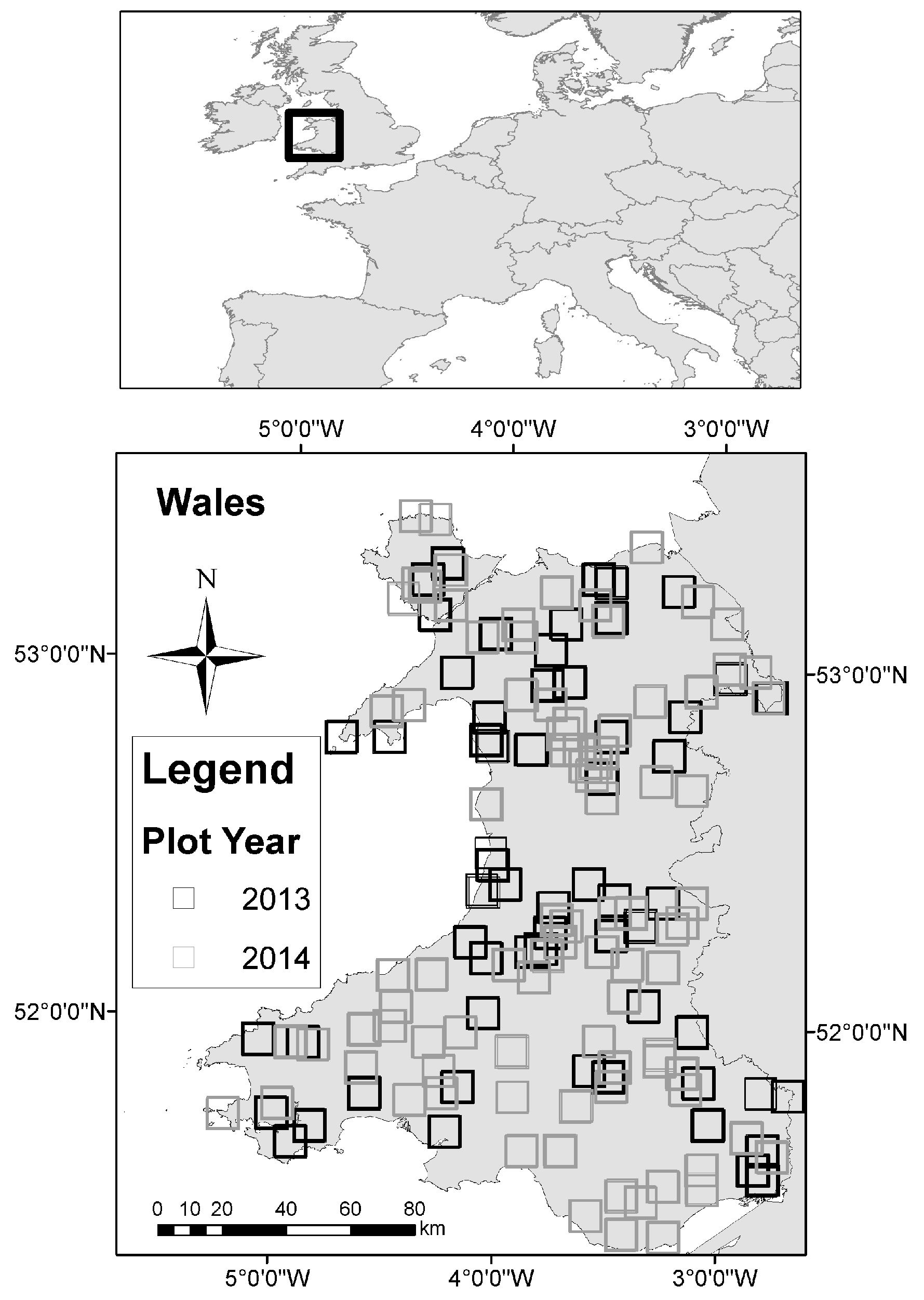
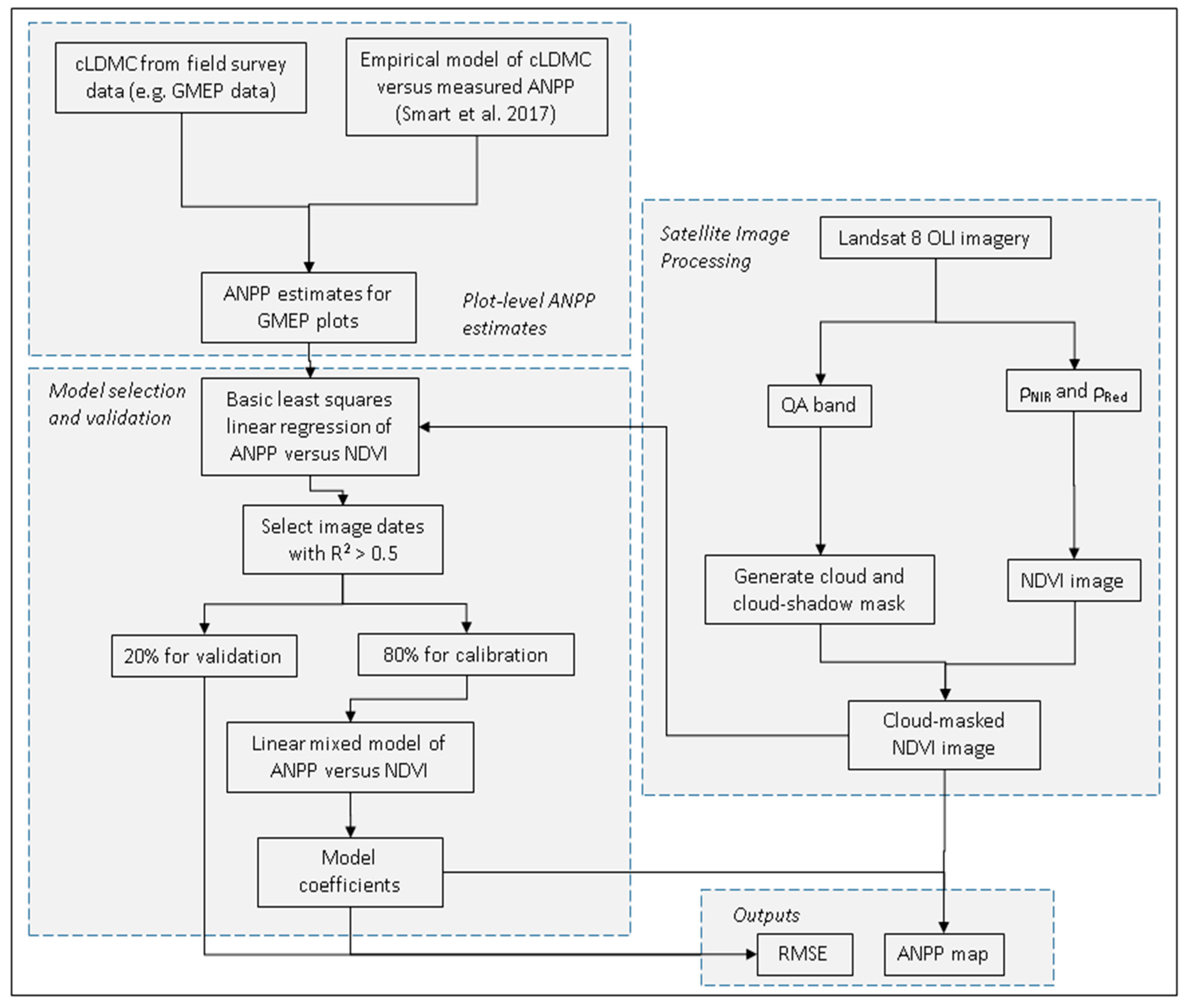
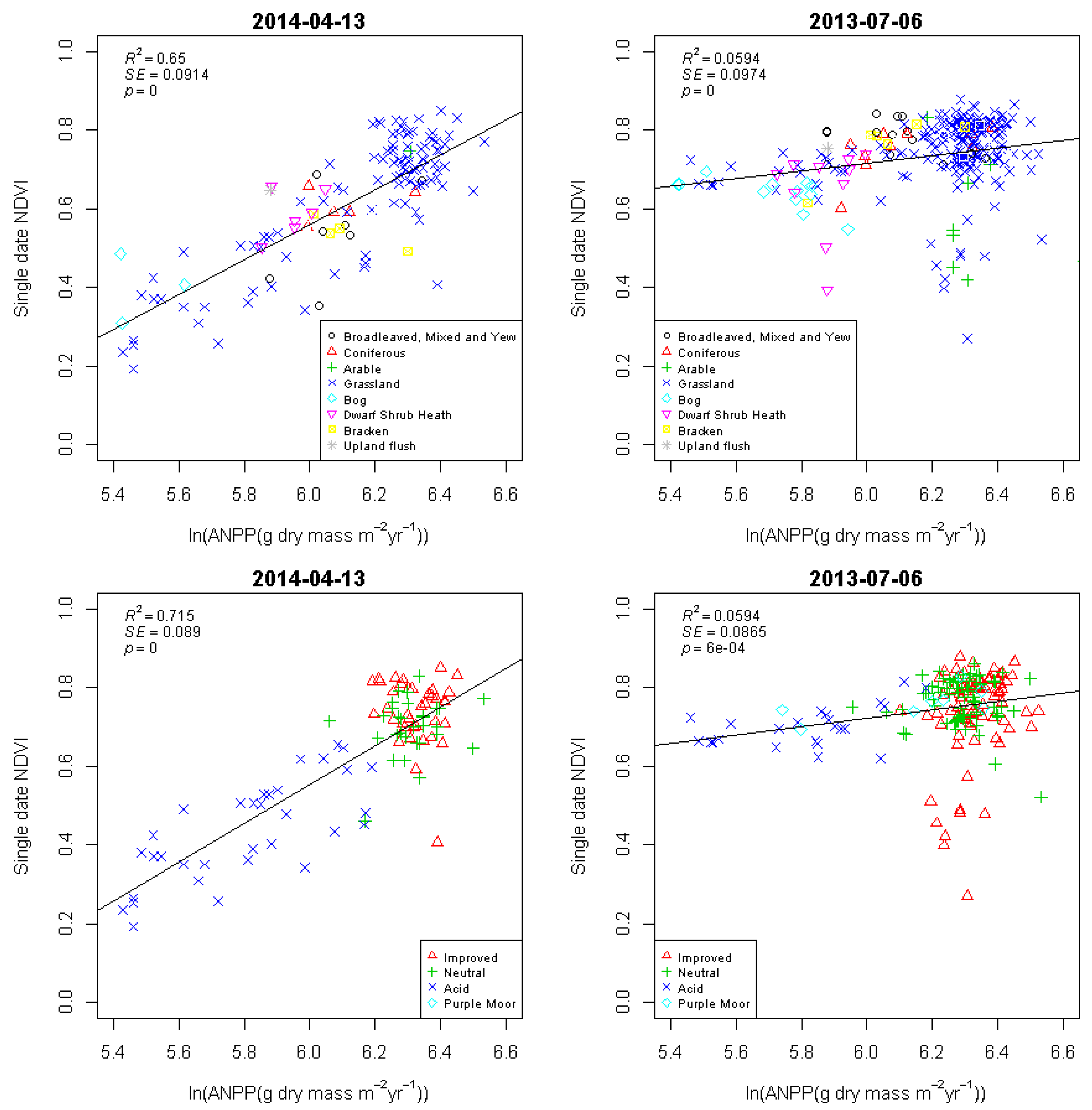
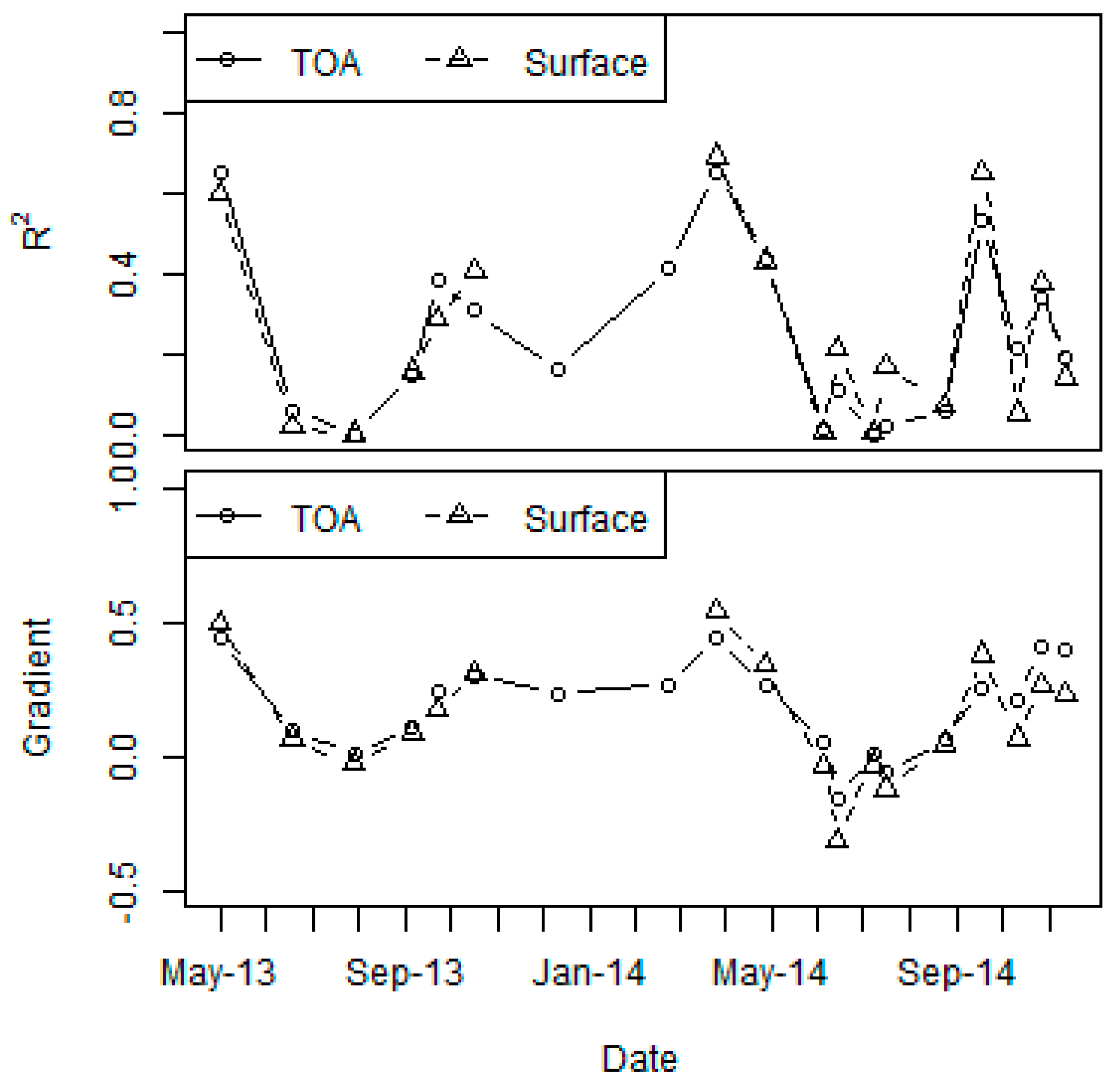
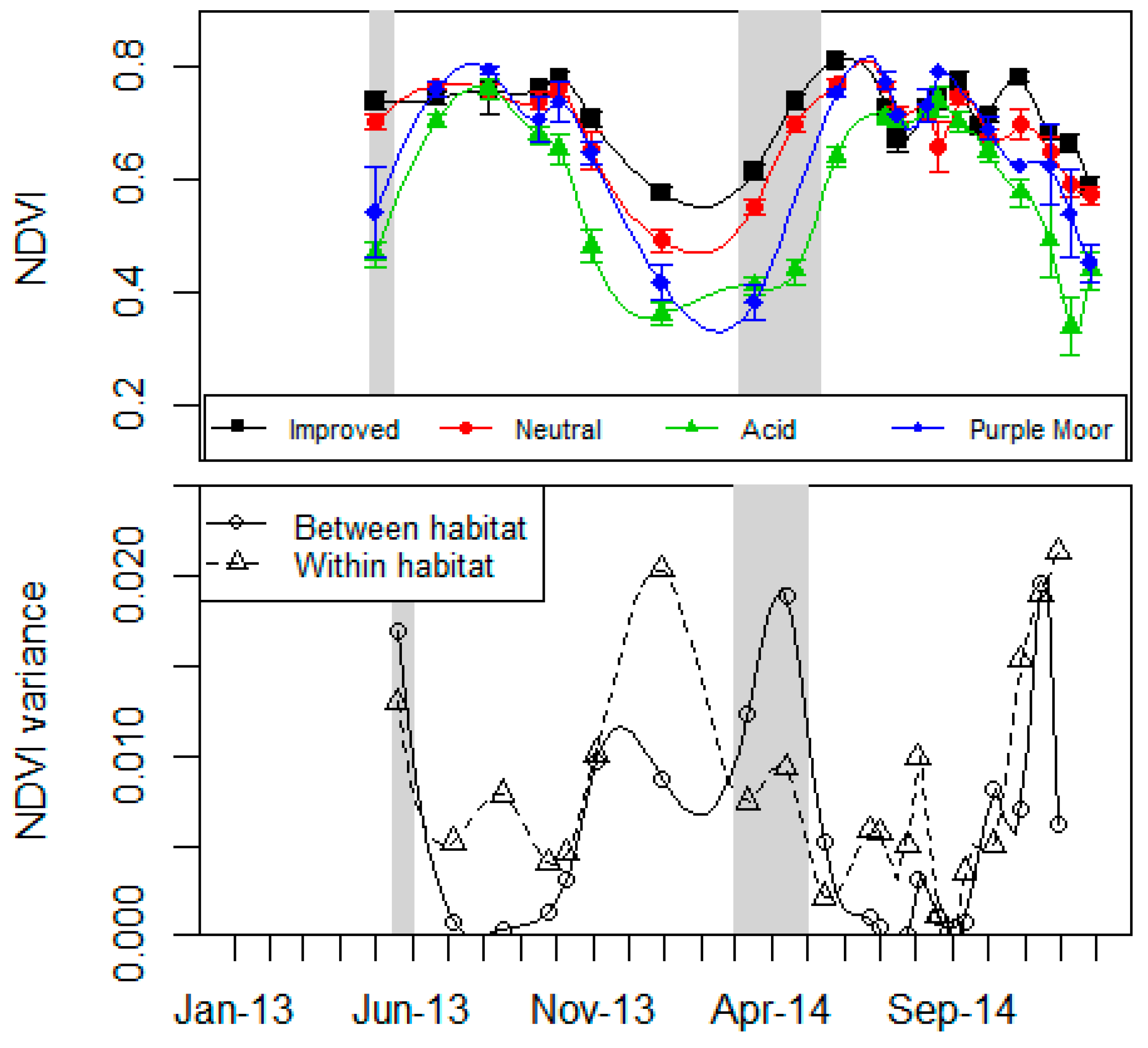

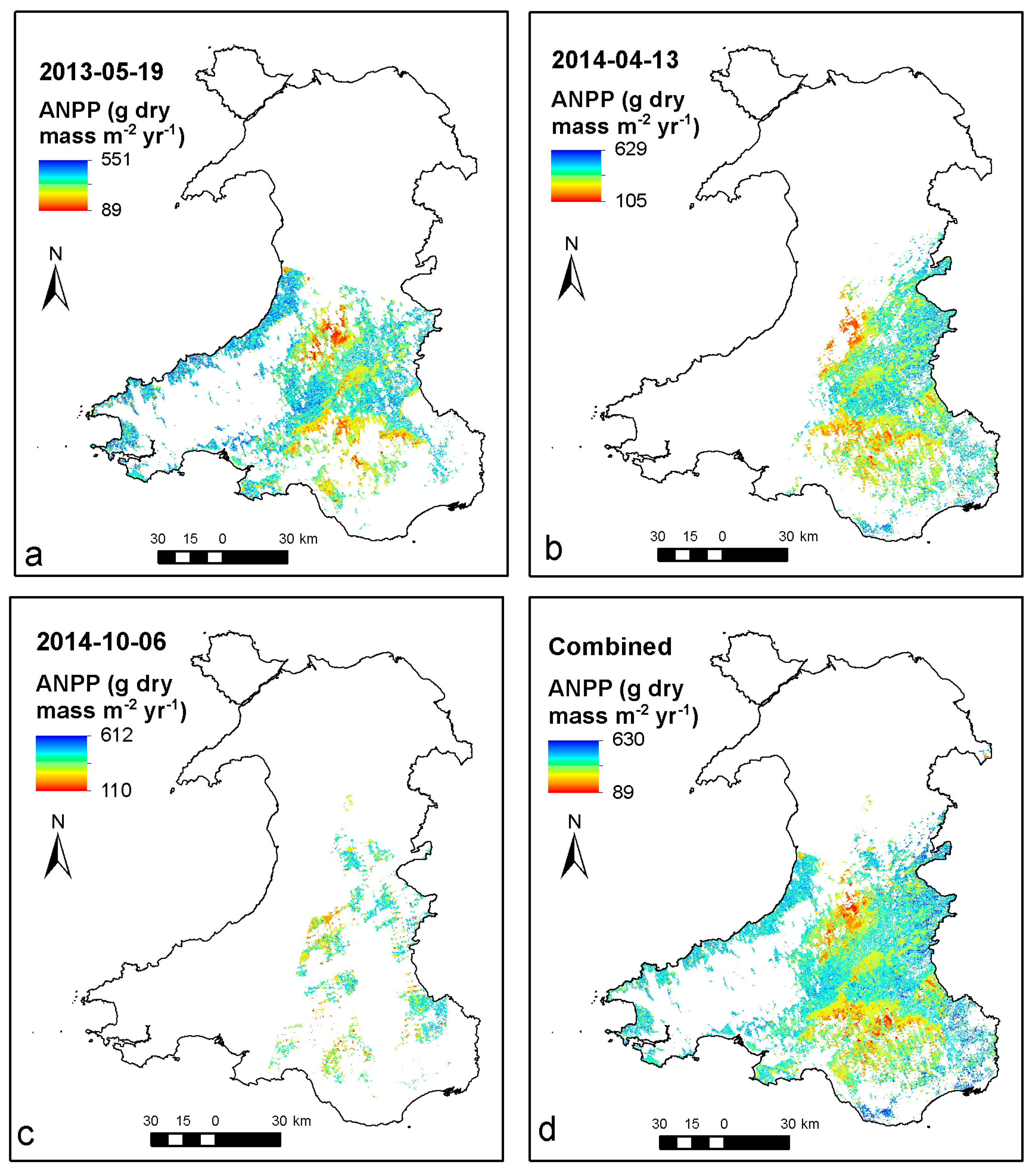
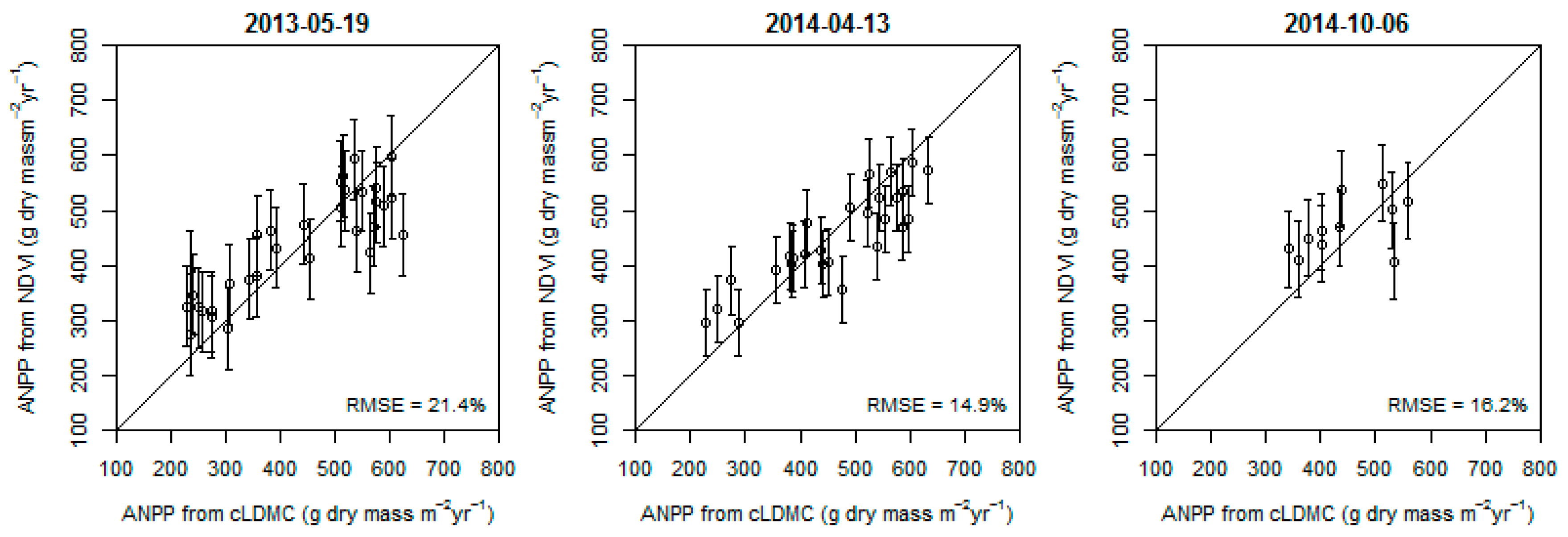
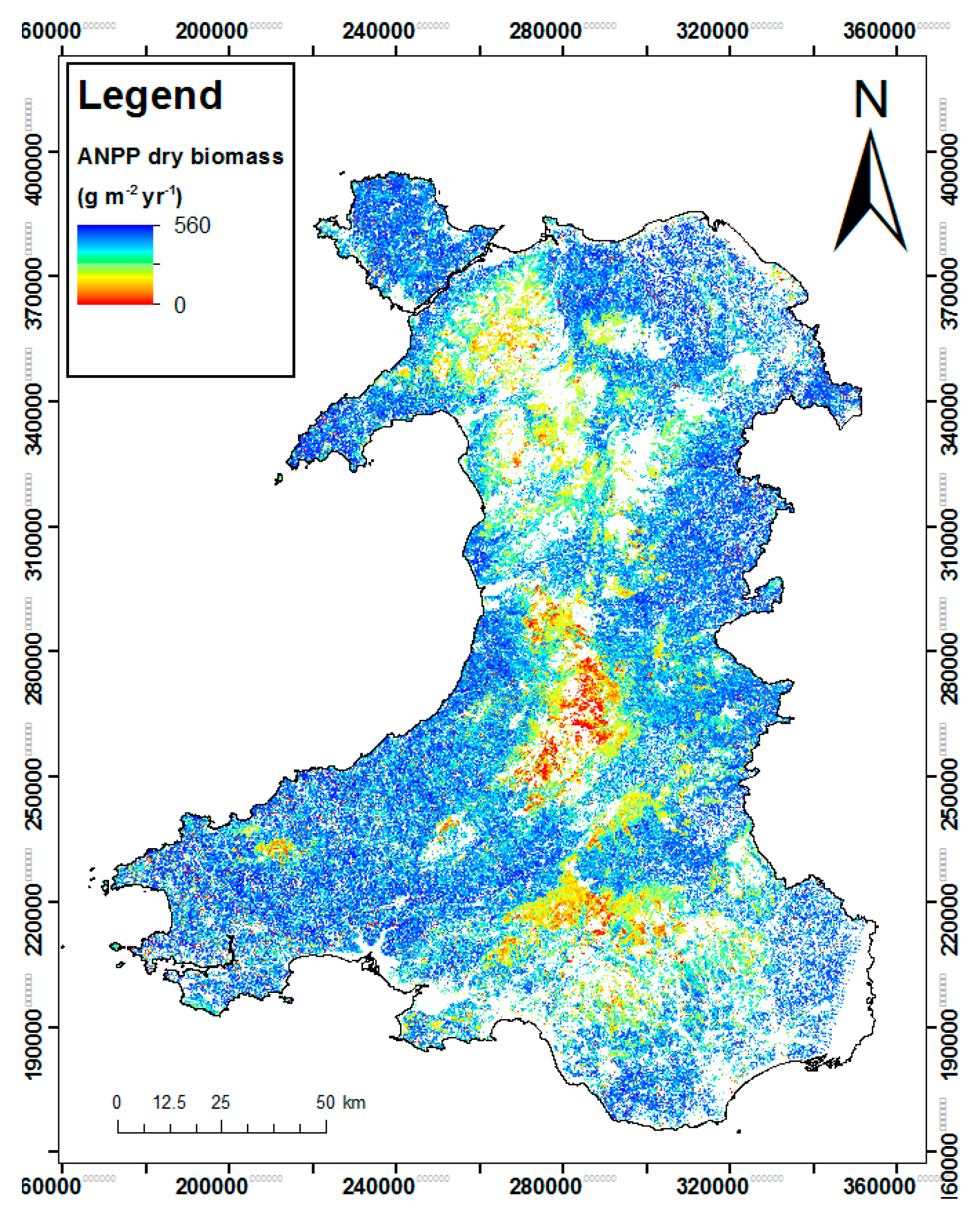
| Date | Landsat Scene IDs |
|---|---|
| 19 May 2013 | LC82040242013139LGN01 |
| 6 July 2013 | LC82040232013187LGN00, LC82040242013187LGN00 |
| 16 August 2013 | LC82030242013228LGN00 |
| 24 September 2013 | LC82040232013267LGN00 |
| 10 October 2013 | LC82040242013283LGN00 |
| 4 November 2013 | LC82030242013308LGN00 |
| 29 December 2013 | LC82040232013363LGN00, LC82040242013363LGN00 |
| 12 March 2014 | LC82030242014071LGN00 |
| 13 April 2014 | LC82030242014103LGN00 |
| 15 May 2014 | LC82030242014135LGN00 |
| 23 June 2014 | LC82040232014174LGN00, LC82040242014174LGN00 |
| 2 July 2014 | LC82030242014183LGN00 |
| 25 July 2014 | LC82040232014206LGN00, LC82040242014206LGN00 |
| 3 August 2014 | LC82030242014215LGN00 |
| 19 August 2014 | LC82030242014231LGN00 |
| 4 September 2014 | LC82030242014247LGN00 |
| 11 September 2014 | LC82040232014254LGN00, LC82040242014254LGN00 |
| 6 October 2014 | LC82030242014279LGN00 |
| 29 October 2014 | LC82040232014302LGN00 |
| 14 November 2014 | LC82040232014318LGN00 |
| 30 November 2014 | LC82040232014334LGN00, LC82040242014334LGN00 |
| Broad Habitat | No. Samples | Mean ANPP (Dry Mass g·m−2·year−1) |
|---|---|---|
| Broadleaved Mixed and Yew Woodland | 44 | 438 ± 67 |
| Coniferous Woodland | 43 | 399 ± 50 |
| Arable and Horticulture | 14 | 664 ± 230 |
| Improved Grassland | 204 | 561 ± 49 |
| Neutral Grassland | 166 | 542 ± 55 |
| Acid Grassland | 88 | 354 ± 80 |
| Bracken | 15 | 430 ± 55 |
| Dwarf Shrub Heath | 25 | 363 ± 39 |
| Fen, Marsh, Swamp | 30 | 412 ± 97 |
| Bog | 51 | 299 ± 45 |
| TOA Reflectance | Surface Reflectance | |||
|---|---|---|---|---|
| Date | R2 | SE | R2 | SE |
| 19 May 2013 | 0.607 | 0.163 | 0.600 | 0.165 |
| 13 April 2014 | 0.706 | 0.157 | 0.690 | 0.157 |
| 6 October 2014 | 0.566 | 0.176 | 0.648 | 0.155 |
| R2 | |||
|---|---|---|---|
| Date | All Data | 2013 Only | 2014 Only |
| 19 May 2013 | 0.648 | 0.703 | 0.607 |
| 13 April 2014 | 0.65 | 0.507 | 0.706 |
| 6 October 2014 | 0.529 | 0.492 | 0.566 |
| Date | Gradient, m | Intercept, c | Variance Explained by the Square | Residual Variance | No. of Field Plots |
|---|---|---|---|---|---|
| 19 May 2013 | 1.10 | 5.42 | 0.0103 | 0.0210 | 128 |
| 13 April 2014 | 1.31 | 5.32 | 0.0150 | 0.0168 | 109 |
| 6 October 2014 | 1.81 | 4.85 | 0.0130 | 0.0316 | 42 |
© 2017 by the authors. Licensee MDPI, Basel, Switzerland. This article is an open access article distributed under the terms and conditions of the Creative Commons Attribution (CC BY) license (http://creativecommons.org/licenses/by/4.0/).
Share and Cite
Tebbs, E.J.; Rowland, C.S.; Smart, S.M.; Maskell, L.C.; Norton, L.R. Regional-Scale High Spatial Resolution Mapping of Aboveground Net Primary Productivity (ANPP) from Field Survey and Landsat Data: A Case Study for the Country of Wales. Remote Sens. 2017, 9, 801. https://doi.org/10.3390/rs9080801
Tebbs EJ, Rowland CS, Smart SM, Maskell LC, Norton LR. Regional-Scale High Spatial Resolution Mapping of Aboveground Net Primary Productivity (ANPP) from Field Survey and Landsat Data: A Case Study for the Country of Wales. Remote Sensing. 2017; 9(8):801. https://doi.org/10.3390/rs9080801
Chicago/Turabian StyleTebbs, Emma J., Clare S. Rowland, Simon M. Smart, Lindsay C. Maskell, and Lisa R. Norton. 2017. "Regional-Scale High Spatial Resolution Mapping of Aboveground Net Primary Productivity (ANPP) from Field Survey and Landsat Data: A Case Study for the Country of Wales" Remote Sensing 9, no. 8: 801. https://doi.org/10.3390/rs9080801




